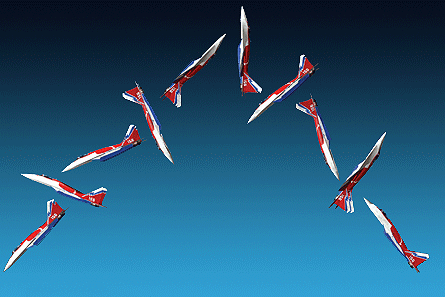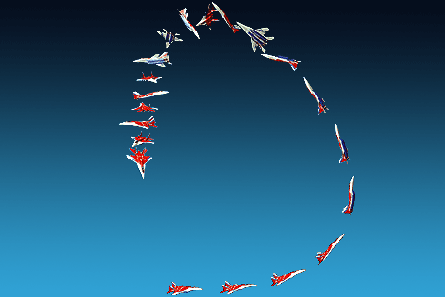Russian manufacturer RSK MiG is offering the ultimate prize for the aviation enthusiast – a trip to Russia and a flight in a MiG-29. The prize is on offer to the lucky person who can come up with names for the four new aerobatic manoeuvres flown by the unique vectored-thrust MiG-290VT in its Farnborough display (pictured below).
The prize is available to visitors to the air show, where the aircraft is the star of the flying display. RSK MiG is asking spectators to name the four new manoeuvres flown by the Russian air force's Swifts aerobatic display team by dropping into the manufacturer's chalet. There will be a number of prizes for the best suggestions – but the overall winner will win the mouth-watering trip to Moscow, as RSK MiG’s guest. Readers can also email RSK MiG, although the prize is not open to non-Farnborough attendees.




The MiG-29, often a star performer in the Farnborough flying display since making its Western debut here in 1988, returns this year in its newest and most impressive guise, wearing an enormous red star on its spine and centre fuselage.
Beneath its striking red, white and blue livery (modeled on that of the Russian air force’s Swifts aerobatic team), the MiG-29M OVT is a company-owned workhorse. It was previously seen at Farnborough as the sixth and final prototype for the MiG-29M ‘Super Fulcrum’, wearing camouflage and the Bort number 156.
The aircraft is now used as a demonstrator for the new RD-33 OVT engine, which incorporates three-dimensional thrust vectoring nozzles, giving the aircraft an astonishing degree of agility, and enabling it to perform manoeuvres never before seen at a Farnborough airshow.
The aircraft is flown by Pavel Vlasov, the MiG Russian Aircraft Corp (RAC MiG) chief test pilot and by his colleague, Mikhail Belyaev.
Vlasov, who is also director of RAC MiG’s Fedorov Flight Test Centre, will be a familiar figure to many Farnborough regulars, having displayed a number of MiG-29 variants in previous years, usually backing up former chief test pilot Roman Taskaev.
The aircraft, previously widely referred to as the MiG-29OVT, has been flying in its current configuration since August 2003. It has now completed more than 110 flights, and development of the integrated system controlling the aerodynamic surfaces and the vectoring nozzles is now said to be complete.
Vlasov however has said: “Though we have been fully satisfied by the results achieved, at the same time the new control capabilities have not been finalised yet, and we will continue our work to further extend the aircraft’s manoeuvrability.”
Serious work on thrust vectoring in Russia started during the 1980s, with Sukhoi and engine design bureau Saturn/Lyulka leading the way. As a result of this early work, the latest Su-30MKI aircraft delivered to the Indian air force are powered by AL-31FP engines with two dimensional (up/down) nozzles that move 15°.
MiG and Klimov began work a little later, with early improvement of the basic RD-33 engine focusing on improving reliability, service life, time between overhauls and thrust. A digital Fadec control system was designed and incorporated before serious thoughts turned to thrust vectoring.
The OVT programme began during the 1990s and from the start, Klimov and MiG decided to aim for all-aspect thrust vectoring, with nozzles that could move in any direction. Klimov achieved this by using three hydraulic actuators to deflect the nozzles, mounted at 120° intervals around the engine nacelle.
In a further effort to improve on rival Saturn’s two dimensional 15° system, Klimov’s three dimensional system has 18° movement in all directions. Nor has this been achieved at the expense of reliability, says Vlasov, who comments that: “Though everybody was afraid that the life cycle of the moveable hardware would be very short, to the great credit of the engine manufacturer, I can say that during two years of test flights not even one small part both in engines and nozzles has had to be replaced.”
Because the thrust vectoring system is integrated with the later digital fly-by-wire control system of the later MiG-29M and its derivatives (and not with the analogue, electro-mechanical system of the baseline MiG-29) there is little scope for retrofitting in-service MiG-29s with thrust vectoring, and MiG had to use a MiG-29M as the test aircraft.
The OVT engines were installed in the MiG-29M during 2001, and there were then extensive ground trials. The MiG-29M OVT made its public debut at the Moscow air display (MAKS-2005) in August last year, and then gave a show-stopping, jaw-dropping performance at this year’s Berlin airshow. The aircraft comes to Farnborough fresh from displaying at RIAT.
The MiG-29M OVT’s display demonstrates the aircraft’s ability to fly at very low speeds without angle of attack limitations, and to remain controllable in zero-speed and negative-speed (tail forward) areas of the envelope for sustained periods, where previous Russian fighters could only venture momentarily – for example during a tailslide or ‘kobra’ manoeuvre.
The new control system gives the pilot an unparalleled ability to point the aircraft (and thus his missile seekers) ‘off axis’, away from the direction of flight.
The display includes a number of unique manoeuvres, including the ‘double kul’bit’ (double somersault) and the ‘boomerang’, but Vlasov maintains that the aircraft remains easy to fly. Changes to the MiG-29M cockpit are limited, he says: “Only one switch was added: OVT mode on/off.” As a result, it “would take not more than 60 flights for MiG-29 pilots to master the new version with thrust vectoring.
“The use of all-aspect OVT will make the handling of the MiG-29M/M2 more precise and effective. This will be not only during ‘super manoeuvres’ (at very low speed and very low angles of attack) but also in normal piloting, though aircraft controllability will be practically independent of the angle of attack.
“This will considerably improve the flight safety close to the limits, and will decrease the pilot’s workload, freeing him to focus more attention on mission requirements.”
MiG claims that tiny changes in nozzle position during normal flight will stabilise the aircraft, reducing the need for conventional trimming, and thereby reducing both drag and fuel consumption.
Though the MiG-29M OVT is a technology demonstrator, the new RD-33OVT engine is ready for production, and is being marketed with the new MiG-29M/M2 now being offered to export customers, including India, where the type will be tendered to meet the Indian air force MMRCA (Medium Multi-Role Combat Aircraft) requirement.
The new MiG-29M/M2 has a Tikhomirov NIIP Bars-29 phased array electronically scanned radar, in addition to thrust vectoring and a modified flight control system, and may be marketed under the designation MiG-35.
Source: Flight Daily News
















